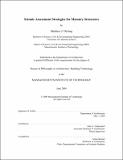Seismic assessment strategies for masonry structures
Author(s)
DeJong, Matthew J. (Matthew Justin)
DownloadFull printable version (8.949Mb)
Other Contributors
Massachusetts Institute of Technology. Dept. of Architecture.
Advisor
John A. Ochsendorf.
Terms of use
Metadata
Show full item recordAbstract
Masonry structures are vulnerable to earthquakes, but their seismic assessment remains a challenge. This dissertation develops and improves several strategies to better understand the behavior of masonry structures under seismic loading, and to determine their safety. The primary focus is on historic arched or vaulted structures, but more modern unreinforced masonry structures are also considered. Assessment strategies which employ simplified quasi-static loading to simulate seismic effects are initially addressed. New analysis methods which focus on stability or strength are presented, and the merits of these strategies are clarified. First, a new parametric graphical equilibrium method is developed which allows real-time analysis and illuminates the complex stability of vaulted masonry structures. Second, a finite element strategy for predicting brittle fracture of masonry structures is extended to incorporate non-proportional loading and shell elements. These extensions enable prediction of damage and collapse mechanisms in general, but are specifically used to predict the response of a full-scale masonry structure to quasi-static cyclic loading. Subsequently, assessment methods based on the dynamic response of masonry structures under earthquake loading are presented. First, rigid body dynamics and an experimental testing program are used to characterize the rocking response of the masonry arch for the first time. (cont.) An assessment criterion is developed which successfully predicts experimentally observed arch collapse under a variety of earthquake time histories. Second, the behavior of rocking structures is addressed in general, and clearly distinguished from typical dynamic oscillators. The rocking response is time dependent, evoking the development of a statistical method for predicting collapse. Finally, the ability of discrete element methods to predict the dynamics of masonry structures is evaluated through comparison with analytical and experimental results, and a rational method for assigning modeling parameters is proposed.
Description
Thesis (Ph. D.)--Massachusetts Institute of Technology, Dept. of Architecture, 2009. This electronic version was submitted by the student author. The certified thesis is available in the Institute Archives and Special Collections. Includes bibliographical references (p. 181-189).
Date issued
2009Department
Massachusetts Institute of Technology. Department of ArchitecturePublisher
Massachusetts Institute of Technology
Keywords
Architecture.